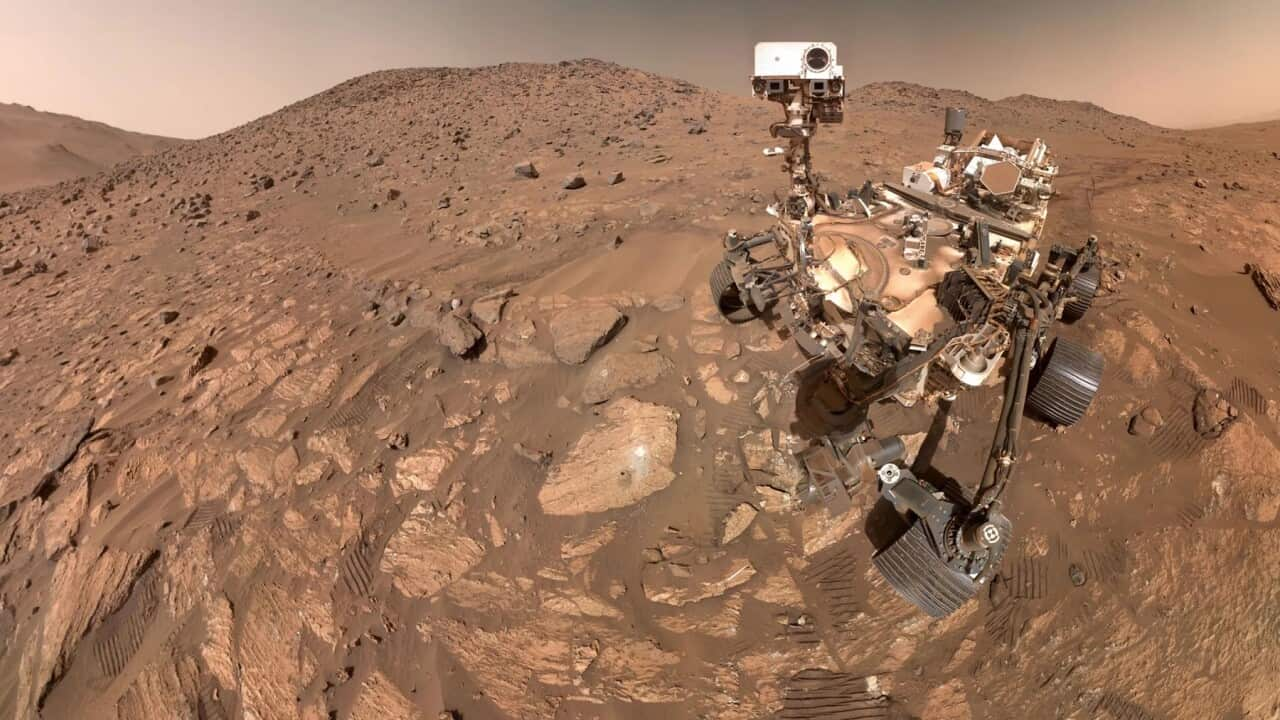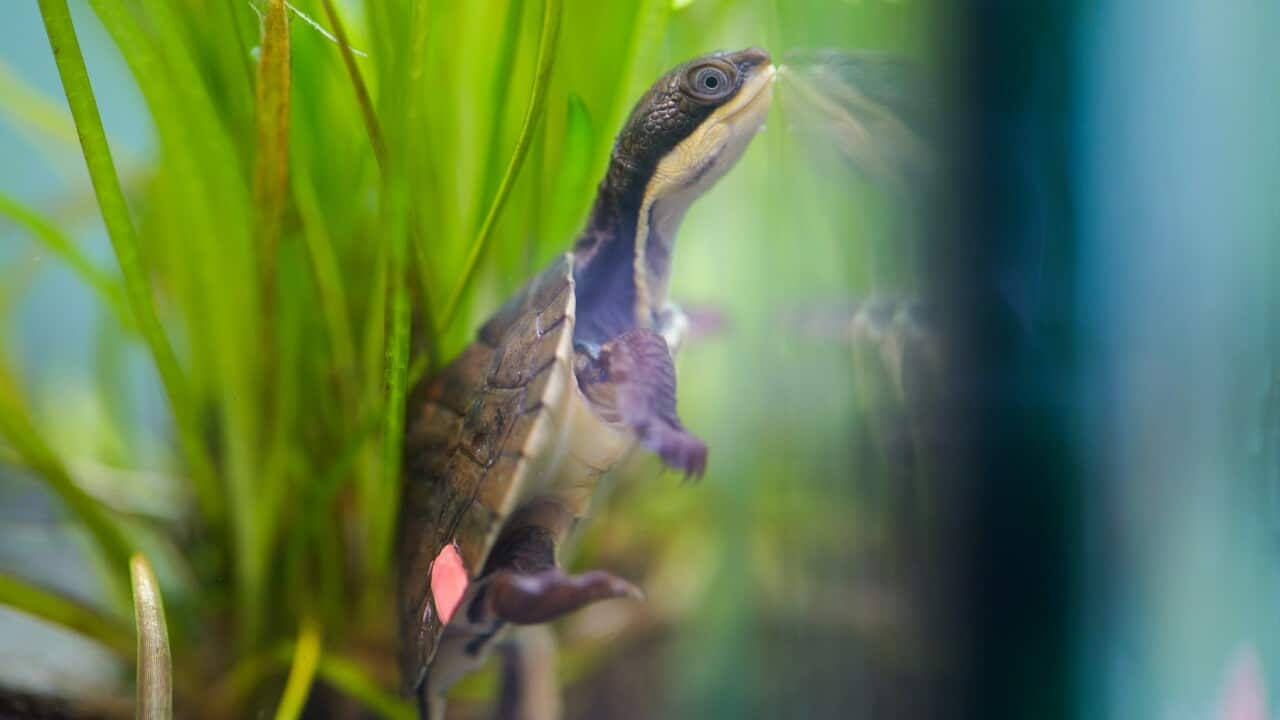English
In 1971, the first orbital mission to Mars changed the way humans understood the red planet.
Imagery from NASA's Mariner 9 mission proved that life on Mars was not just science fiction.
In that archival footage from NASA, evidence of ice caps on Mars was provided for the first time during a press conference.
"Our data are consistent with and suggest that the polar cap is composed of water ice and probably not solid Co2, in the region near the edge of the polar cap. Polar ice provides a reservoir of water. The solid carbon dioxide cloud provides protection from ultraviolet radiation; a region certainly deserving further exploration."
Now, new data analysis indicates there may be deep and expansive reservoirs of liquid water far below the surface of Mars.
Vashan Wright is an Assistant Professor at the University of California San Diego’s Scripps Institute of Oceanography, and has been leading the research.
Mr Wright says understanding the Martian water cycle is critical for understanding the evolution of the planet itself.
"So finding water in liquid form and Mars is important because water affects just about everything about our planet's evolution. In Mars we get to see a water cycle without humans. We know that water is a key ingredient for life as we know it and it means that it's potentially habitable in the mid crust of Mars. And so there's just so much to learn when you know where the water went. Mars once looked like Earth 3 billion years ago and now it doesn't. It's dry and it's desolate and so a big question is where is the water? Where did it go? And so finding it there in the volumes that we found it is really important and exciting."
The findings are based on computer modelling as well as seismic measurements from NASA's InSight lander.
The Lander ended its mission in 2022 after spending four years sitting quietly listening to the seismic pulse of the red planet.
It detected more than 1,300 marsquakes before shutting down.
And in case you've ever wondered what exactly Mars sounds like, NASA's Perseverance Rover brought along a microphone.
So - how did a mission that went to Mars to analyse marsquakes and seismic activity discover what may be an ocean's worth of water over 10 kilometres below the surface?
The CSIRO's Glen Nagle works for the Canberra Deep Space Communication Complex as a part of NASA's Deep Space Network.
"As those vibrations travel through the planet they pass through different mediums, different materials which then produce a different frequency at the return receiver on the spacecraft. And those signals seem to indicate that about 10 to 20 kilometres below the Martian surface is a sufficient amount of water, either locked up with minerals, or as a large aquifer below the surface, enough water potentially cover all of Mars. Under about one or two kilometres worth of water."
Scientists say the water most likely seeped from the planet's surface billions of years ago, when Mars had rivers and lakes across its surface.
The discovery not only raises further questions about whether life has ever or could ever exist on Mars, but it also poses the question about whether life exists on Mars right now.
Billionaire businessman and founder of SpaceX Elon Musk has, for decades, touted his lifelong goal of reaching Mars.
In a speech delivered in 2017, Mr Musk told an audience about his plans to colonise Mars within the next few decades.
"So there's been a lot of great work by NASA and other organizations in early exploration of Mars, and understanding what Mars is like, where could we land. What's the composition of the atmosphere, where is there water order. Water ice, I should say. And so we need to go from these early exploration missions to actually building a city."
Mr Nagle says even if life does exist on Mars, sustaining human life isn't that simple.
"We've now known for many decades that water existed on Mars on its surface in the forms of rivers and lakes, and oceans and salty seas. That always lends possibility to life on that planet. But before we send humans to Mars. That is the ultimate question, we need to answer, is there life on that planet, either on or below the surface, and could we as human beings risk wiping out that life with our own germs and diseases, or the reverse be true, that life have something we can't handle and cause damage to all of us. So the big question we need to answer about the red planet is about its past habitability, but also its present habitability and the past the possibility of even microbial life on a world like that."
Italian
Nel 1971, la prima missione spaziale su Marte cambiò il modo in cui l'uomo intendeva il pianeta rosso.
Le immagini della missione Mariner 9 della NASA dimostrarono che la vita su Marte non era solo fantascienza.
In quel filmato d'archivio della NASA, durante una conferenza stampa vennero fornite per la prima volta le prove della presenza di calotte di ghiaccio su Marte.
"Our data are consistent with and suggest that the polar cap is composed of water ice and probably not solid Co2, in the region near the edge of the polar cap. Polar ice provides a reservoir of water. The solid carbon dioxide cloud provides protection from ultraviolet radiation; a region certainly deserving further exploration."
Ora, l'analisi di nuovi dati indica che potrebbero esserci profonde ed estese riserve di acqua liquida molto al di sotto della superficie di Marte.
Vashan Wright è assistente professore presso il San Diego Scripps Institute of Oceanography della University of California e ha guidato la ricerca.
Secondo Wright, la comprensione del ciclo dell'acqua marziana è fondamentale per capire l'evoluzione del pianeta stesso.
"So finding water in liquid form and Mars is important because water affects just about everything about our planet's evolution. In Mars we get to see a water cycle without humans. We know that water is a key ingredient for life as we know it and it means that it's potentially habitable in the mid crust of Mars. And so there's just so much to learn when you know where the water went. Mars once looked like Earth 3 billion years ago and now it doesn't. It's dry and it's desolate and so a big question is where is the water? Where did it go? And so finding it there in the volumes that we found it is really important and exciting."
I risultati si basano sulla modellazione al computer e sulle rilevazioni sismiche effettuate dal lander InSight della NASA.
Il lander ha concluso la sua missione nel 2022 dopo aver trascorso quattro anni in silenzio ad ascoltare le pulsazioni sismiche del pianeta rosso.
Ha rilevato più di 1.300 "martemoti” prima di spegnersi.
E se vi siete mai chiesti che suono abbia esattamente Marte, il rover Perseverance della NASA ha portato con sé un microfono.
Come ha fatto una missione che è andata su Marte per analizzare i "martemoti" e l'attività sismica a scoprire quello che potrebbe essere un mare più di 10 chilometri sotto la superficie?
Glen Nagle del CSIRO lavora per il Canberra Deep Space Communication Complex, che fa parte del Deep Space Network della NASA.
"As those vibrations travel through the planet they pass through different mediums, different materials which then produce a different frequency at the return receiver on the spacecraft. And those signals seem to indicate that about 10 to 20 kilometres below the Martian surface is a sufficient amount of water, either locked up with minerals, or as a large aquifer below the surface, enough water potentially cover all of Mars. Under about one or two kilometres worth of water."
Gli scienziati sostengono che molto probabilmente l'acqua si è infiltrata dalla superficie del pianeta miliardi di anni fa, quando Marte era ricoperto di fiumi e laghi.
La scoperta non solo solleva nuove domande sulla possibilità che la vita sia mai esistita o possa mai esistere su Marte, ma pone anche la questione se la vita possa esistere su Marte in questo momento.
Il miliardario e fondatore di SpaceX Elon Musk ha per decenni dichiarato il suo obiettivo: raggiungere Marte.
In un discorso tenuto nel 2017, Musk illustrò a un pubblico i suoi piani per colonizzare Marte nei prossimi decenni.
"So there's been a lot of great work by NASA and other organizations in early exploration of Mars, and understanding what Mars is like, where could we land. What's the composition of the atmosphere, where is there water order. Water ice, I should say. And so we need to go from these early exploration missions to actually building a city."
Nagle ha affermato che anche se la vita esistesse su Marte, mantenere la vita umana non sarebbe così semplice.
"We've now known for many decades that water existed on Mars on its surface in the forms of rivers and lakes, and oceans and salty seas. That always lends possibility to life on that planet. But before we send humans to Mars. That is the ultimate question, we need to answer, is there life on that planet, either on or below the surface, and could we as human beings risk wiping out that life with our own germs and diseases, or the reverse be true, that life have something we can't handle and cause damage to all of us. So the big question we need to answer about the red planet is about its past habitability, but also its present habitability and the past the possibility of even microbial life on a world like that."




